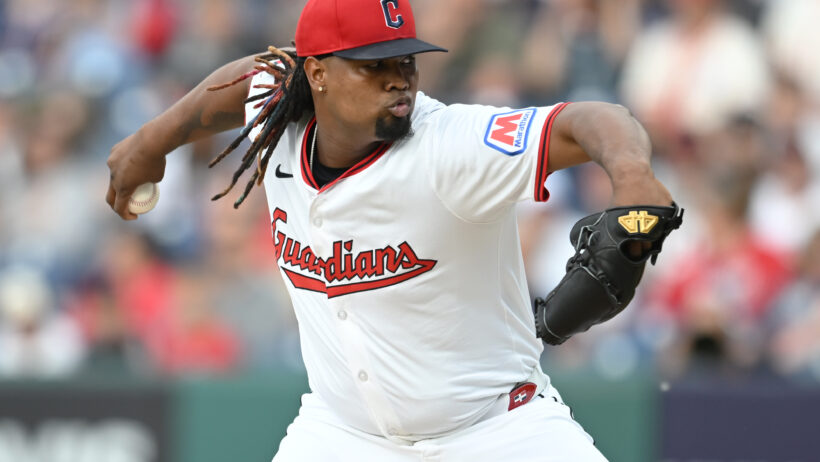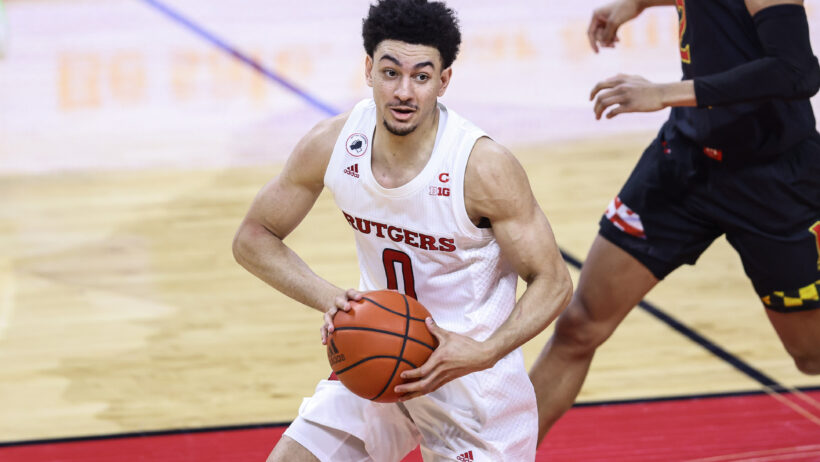How to Read Odds for Sports Betting
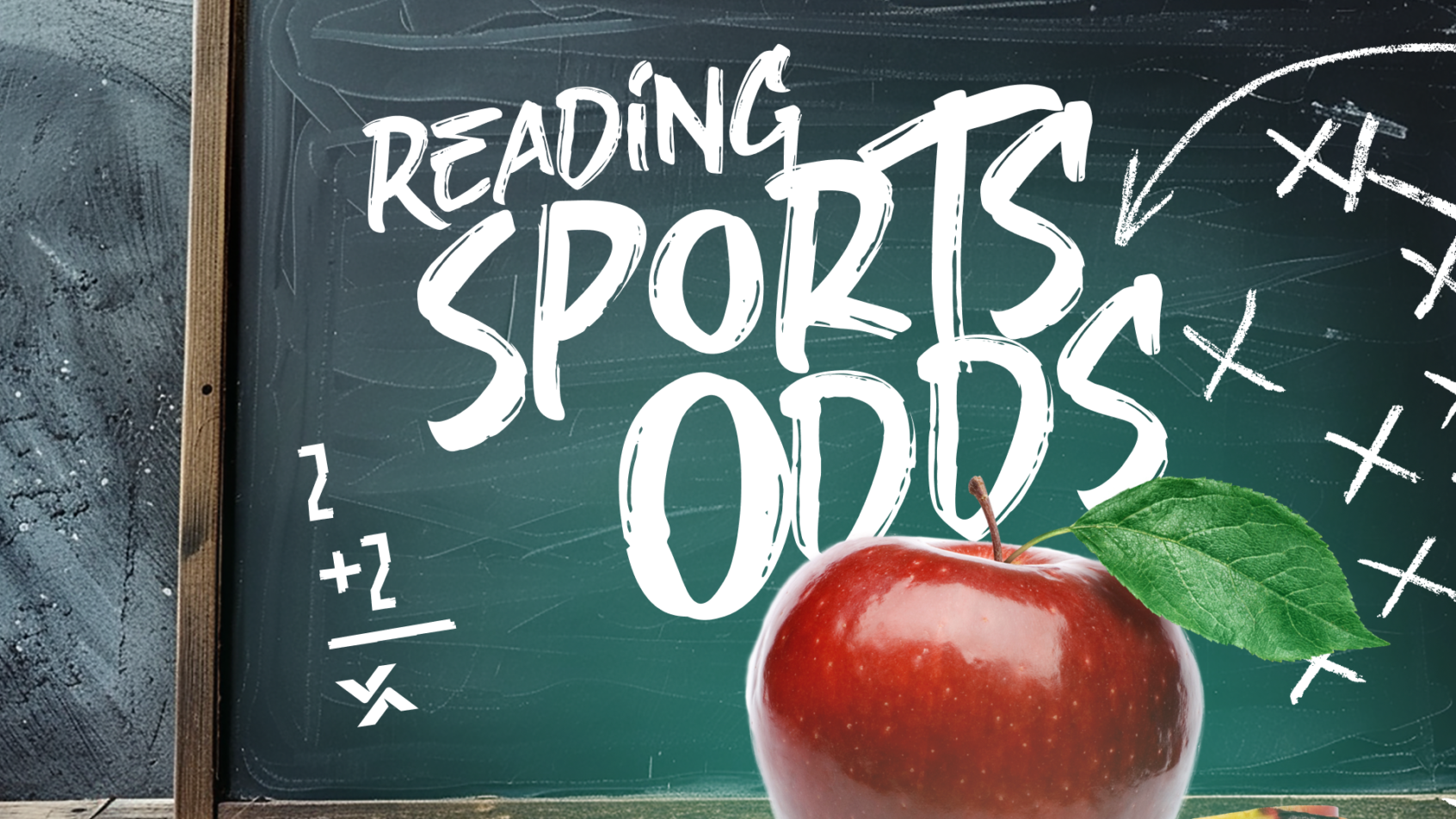
- Understanding odds is the key to figuring out which bets are worth taking
- Odds are displayed in a variety of different formats, but all are easy to understand
- You can use odds to calculate the implied probability of a certain outcome in a sporting event
Understanding how to read betting odds is a crucial step to becoming a successful sports bettor. From determining how much money you want to wager on an NBA, MLB, or NHL game to figuring out which Super Bowl bets offer the most value, it all starts with a solid understanding of how odds work.
- BETMGM SPORTSBOOK
USE CODE SBD1500 & GET $1,500 BACK IN BONUS BETS
- BET365 SPORTSBOOK
BET $5 & GET $150 IN BONUS BETS WITH CODE DIME365
- FANATICS SPORTSBOOK
BET & GET UP TO $1,000 IN BONUS BETS!
- DRAFTKINGS SPORTSBOOK
BET $5 & GET $150 IN BONUS BETS INSTANTLY!
- FANDUEL SPORTSBOOK
BET $5 & GET $150 IF YOUR BET WINS
- CAESARS SPORTSBOOK
USE CODE SBD2DYW & BET $1 TO DOUBLE THE WINNINGS ON YOUR FIRST 10 BETS!
Must be 21+. GAMBLING PROBLEM? Call 1-800-GAMBLER (CO, IL, KS, KY, MD, MI, NC, NJ, OH, PA, TN, VA, VT, WV, WY); (800) 327-5050 or gamblinghelplinema.org (MA); (877) 8-HOPENY (NY); 1-800-NEXT-STEP (AZ); (888) 789-7777 (CT); 1-800-BETS-OFF (IA); 1-800-9-WITH-IT (IN); mdgamblinghelp.org (MD); morethanagame.nc.gov (NC); 1800gambler.net (WV)
How to Read Odds Sections: What Are American, Decimal, & Fractional Odds? / American Odds Explained / Decimal Odds Explained / Fractional Odds Explained / Current Sports Betting Promotions / How to Read Odds FAQ
What Are American, Decimal, & Fractional Odds?
Odds are displayed in either American, Decimal, or Fractional formats, and serve two purposes:
- They signal the implied probability of the outcome they are attached to
- They indicate how much money you could win betting on that outcome
*Be careful relying on the odds alone when evaluating the probability an event will occur. Odds are influenced by more than the factors actually relevant to the outcome of the event.
Your sportsbook may manipulate the odds to incentivize bets on a certain side, and the sum of the probabilities for a single event will always surpass 100 percent because the sportsbook takes a cut that is baked directly into the odds.
Odds also reveal how much the book is charging to take your bet. You may hear bettors refer to this amount as “the juice” or “cut” or “vig(orish).”
American Odds Explained
When you see -150, +230, or any other three-digit number with a minus sign or plus sign in front of it, you’re dealing with American betting odds.
What Do the + and – Mean in Sports Betting?
The – and + on a sports betting line indicates both your potential payout and whether you’re betting on the favorite or the underdog in moneyline odds.
Negative numbers signify the favorite on a moneyline bet. The negative number indicates how much you’d need to bet to win $100.
If there’s a positive number, you’re looking at the underdog, and the number refers to the amount of money you’ll win if you bet $100.
For example:

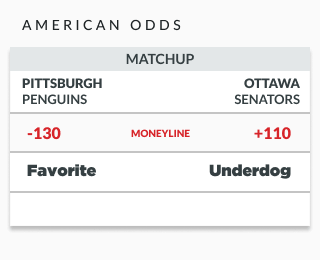
Many popular wagers, including most point spread bets, will see both sides with negative odds. Because the point spread serves to level the playing field between two sides, you’ll often need to risk more than you profit when betting on the spread.
Calculating Winnings with American Odds
In order to win $100 on the Penguins (favorites), you’ll need to wager $130. If you wagered $100 on the Senators (underdogs), you’d be set to win $110.
You can use the formula below to calculate the potential winnings for any value you wish to wager.
If you bet $40 on Pittsburgh (-130), your equation would look like this:

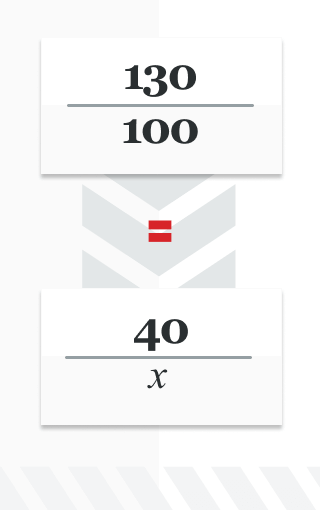
- Cross-multiply to get 130x = 4000, and then solve for “x”
- x= 4000/130
- x = 30.77
Therefore, if you wager $40 on Pittsburgh, you will win $30.77, and your payout would be $70.77 (your original wager plus your winnings). These payouts might change if you’re taking advantage of a sports betting bonus, particularly any ESPN BET promo code you might be using.
If you bet $40 on Ottawa (+110), your equation would look like this:
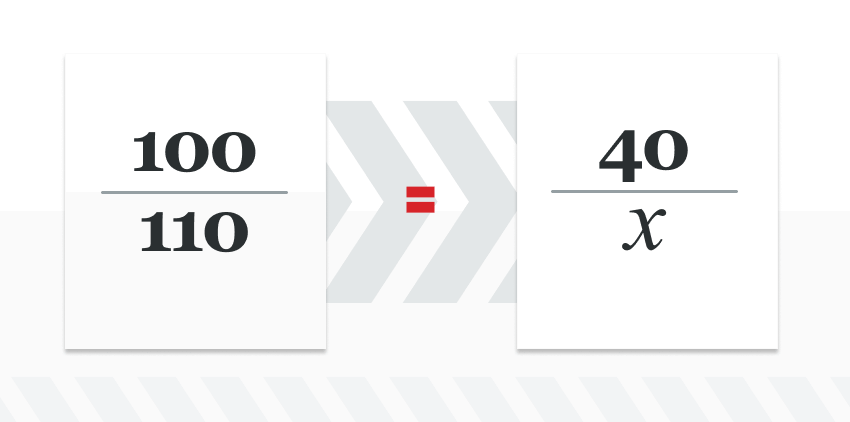
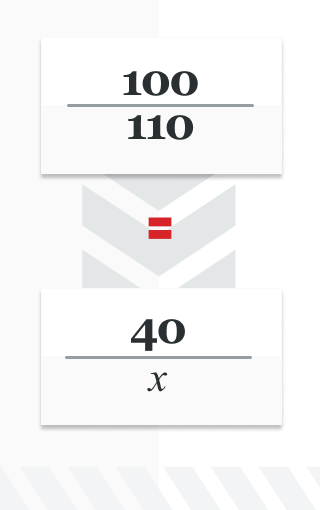
- Cross-multiply to get 100x = 4,400, and then solve for “x”.
- x = 4400/100
- x = 44.00
Therefore, if you wager $40 on Ottawa, you will win $44.00, and your total payout would be $84.00.
Calculating Implied Probability with American Odds
Implied probability refers to the likelihood of a particular outcome suggested by the odds. Figuring it out involves converting odds into a percentage, which indicates the likelihood that event will happen vs. the alternative.
Implied probability is useful because if your estimate of the probability of an event occurring is different than a sportsbook’s you can and should adjust your bet accordingly.
Implied probability is useful because if your estimate of the probability of an event occurring is different than a sportsbook’s you can and should adjust your bet accordingly.
Say you thought one team had a 60% chance of winning, and it was available at 52.4% implied probability. This would be a smart bet.
Of course, if you convert the odds available at your sportsbook into a percentage, they will include the “juice” or the “vig.” Factoring in the “vig,” the implied probability of all possible outcomes of a game will be above 100%. This is called overround, and it explains why you need to remove the vig from betting lines if you want a more accurate picture of what the oddsmakers expect to happen in the game.
Calculating implied probability can be a tad tricky, but the formula is simple in theoretical terms:
Risk/Return = Implied Probability
Let’s take a look at what this looks like with American odds. We’ll start with positive odds because they are the easiest to work with.
Use this Formula with Positive Odds:
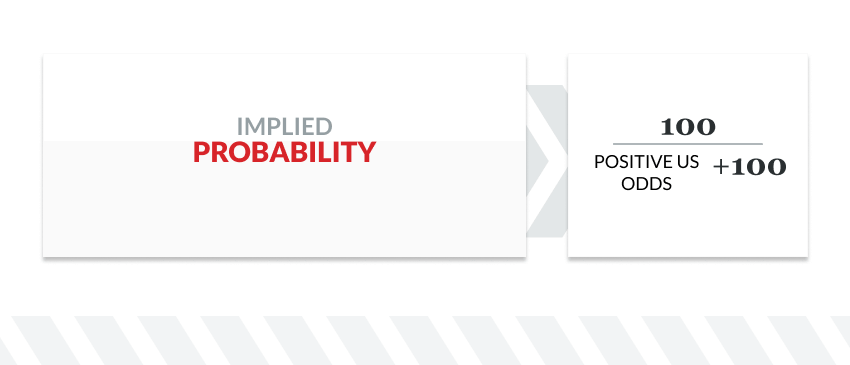
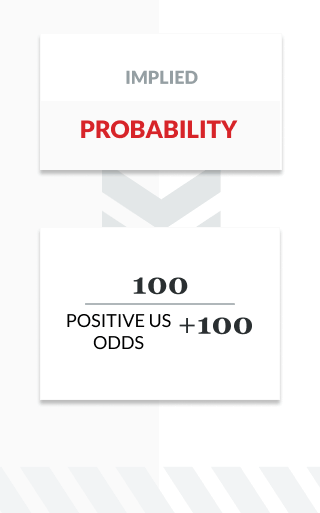
We can calculate Ottawa’s (+110) implied probability of winning the game using this same formula. We cannot use this to calculate Pittsburgh’s, however, because they have negative odds.
Let’s put Ottawa’s odds into the formula:
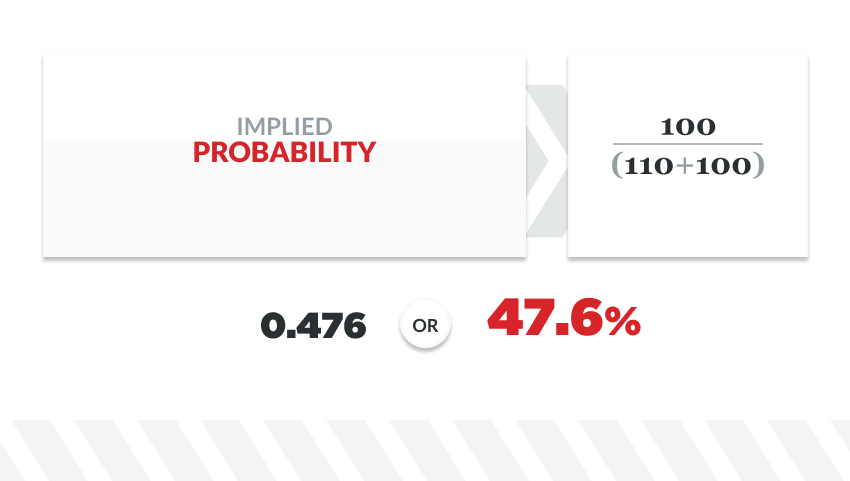
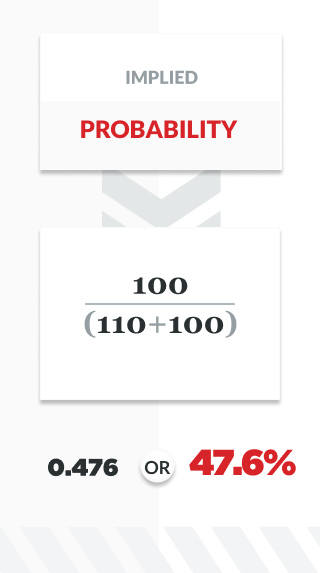
Ottawa, therefore, has a 47.6% chance of winning according to the bookmaker. If you think their chance of winning is higher than that, this bet is worth serious consideration.
How Do Negative Odds Differ?
Don’t get confused by all the brackets and parentheses. Their purpose is to flip the sign on the negative US odds. Here’s the formula:
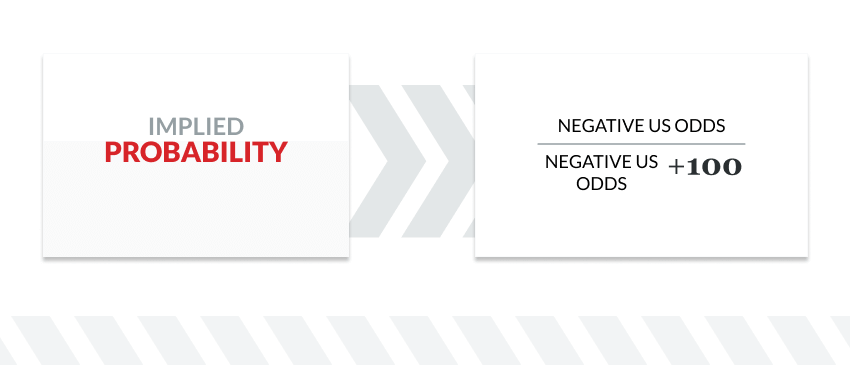
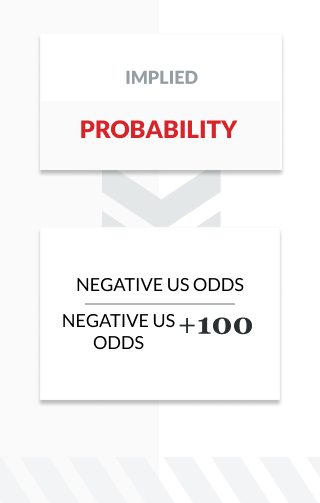
When we use actual numbers, it appears far simpler. Using our example from above, we can calculate Pittsburgh’s (-130) implied probability of winning the game. Remember: We cannot use this to calculate Ottawa’s because they have positive odds.

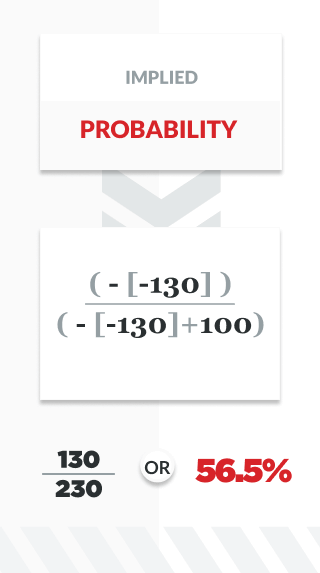
Pittsburgh has a 56.5% chance of winning the game according to the bookmaker.
Let’s See What You’ve Learned
This time, you do the leg-work. Plug the numbers below into the formulae laid out above to answer the following questions, then check your results against the answers further down the page (no peeking!):

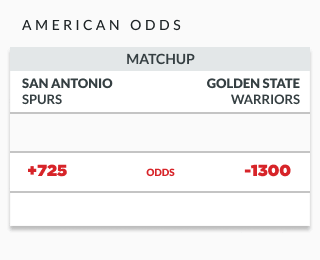
- Probability of San Antonio winning
- Probability of Golden State winning
- Winnings if betting $40 on San Antonio
- Payout if betting $40 on San Antonio
- Winnings if betting $40 on Golden State
- Payout if betting $40 on Golden State
Answers (all percentages are rounded to one decimal place):
- Probability of San Antonio winning: 12.1%
- Probability of Golden State winning: 92.9%
- Winnings if betting $40 on San Antonio: $290.00
- Payout if betting $40 on San Antonio: $330.00
- Winnings if betting $40 on Golden State: $3.08
- Payout if betting $40 on Golden State: $43.08
Decimal Odds Explained
Of the three types of odds you’ll encounter in your betting endeavors, decimal odds are the easiest to work with. Decimal odds are displayed like this:

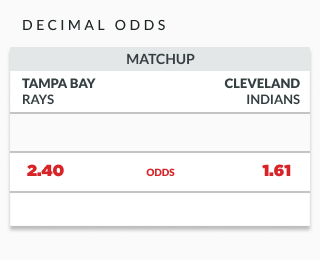
Calculating Winnings with Decimal Odds
Determining your payout with decimal odds is straightforward: simply multiply your wager by the odds associated with the team you are betting on. To calculate a winning bet, subtract the original wager from the payout. Let’s take a look:

Calculating Implied Probability with Decimal Odds
To figure out the implied probability, follow this formula:
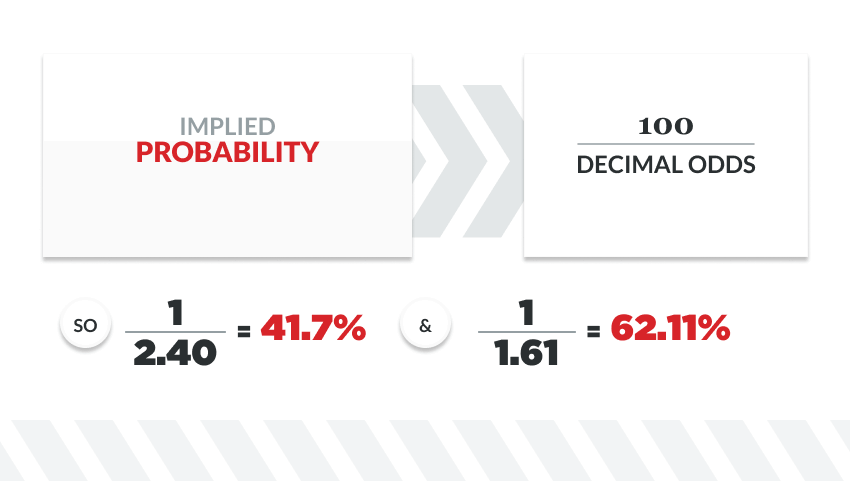
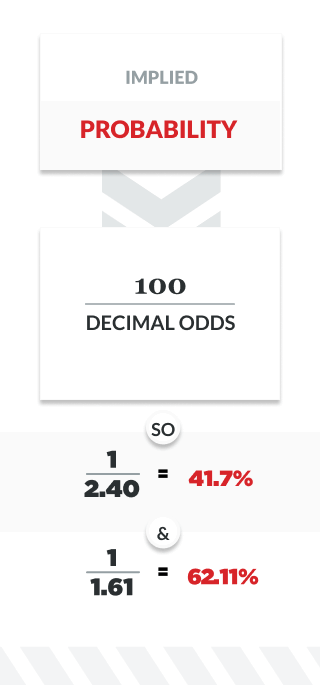
Implied Probability: 1 / Decimal Odds
Using our example from above, the following equation provides Tampa Bay’s implied probability of winning:
Implied Probability: 1 / 2.40 = 41.7%
And Cleveland’s chances of winning:
Implied Probability: 1 / 1.61 = 62.11%
Fractional Odds Explained
Let’s finally move onto fractional odds, which are commonly used in the UK and when betting on horse racing.
These are the funny-looking odds – like 9/5 or 1/2 – that you see when you flip on the Kentucky Derby.
These are the funny-looking odds—like 9/5 or 1/2—that you see when you flip on the Kentucky Derby. Pro tip: if you want to say fractional odds aloud, like 9/5 or 1/2, you would say “nine to five” or “one to two.”
The number on the left (9) dictates how many times the book expects the relevant outcome to fail; whereas the number on the right (5) tells us how many times the outcome is expected to succeed.
Fractional odds can also come in a form where the numbers are stacked on top of each other and there is a numerator (top number) and denominator (bottom number).
Fractional Odds in Action
Let’s say boxer Gennady Golovkin receives 8/13 odds in an upcoming fight with Canelo Alvarez. These odds suggest that if this fight happened 21 times (8 + 13), Golovkin would lose 8 bouts and win 13.
To calculate the implied probability of Golovkin winning the fight, take the number of times he is expected to win (13) and divide it by the total number of trials (21). This results in a 61.9% chance Golovkin will win the fight.
Let’s take a look at the simple math:
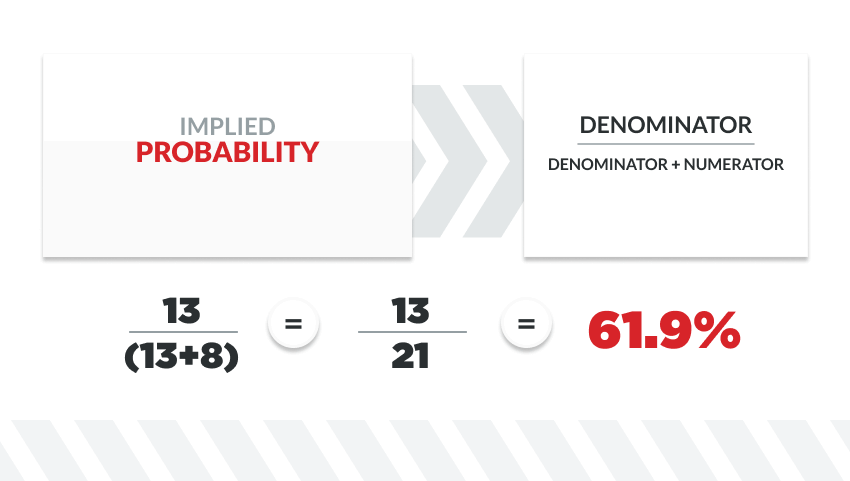
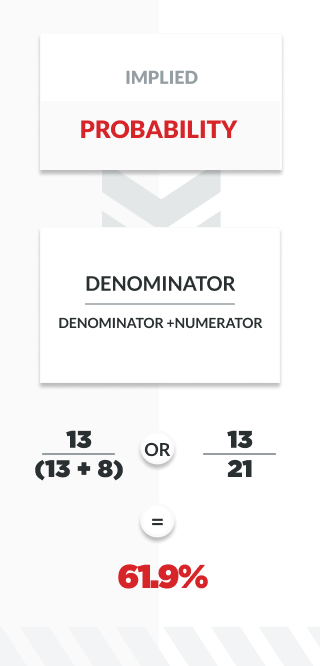
To calculate Alvarez’s probability of winning the match, we do the same thing. Let’s say, hypothetically, odds are 11/8, meaning if the fight happened 19 times (11 + 8), Alvarez would lose 11 times and win 8 times.
Therefore, the probability of Alvarez winning the fight is calculated by dividing 8 (the number of times he would win) by 19 (the total number of trials). Alvarez has a 42.1% chance of winning the fight.
Our formula would look like this:
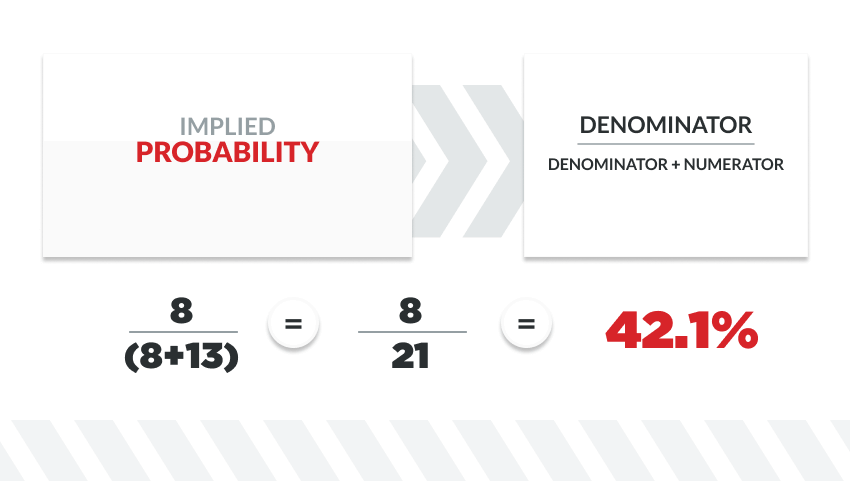
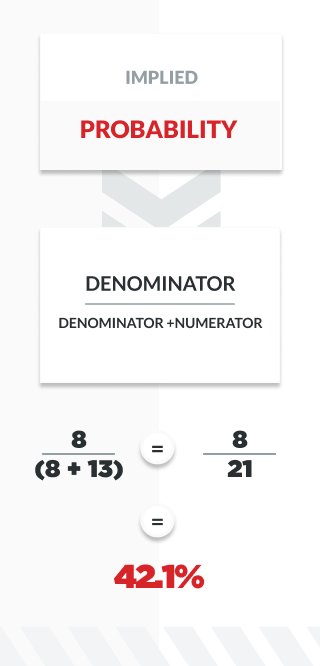
Remember what we said earlier about the “juice” or the “vig”? It doesn’t go away just because the book displays their odds differently. We haven’t even factored in the probability of a draw yet, and the sum of the probabilities is already over 100% (61.9 + 42.1 = 104).
The implied probabilities of both outcomes added together is going to be greater than 100% regardless of the odds format. You’ve got to pay to play, unfortunately.
If you want to bet on Golovkin to win the fight (8/13 odds), calculate your winnings by multiplying your wager by the quotient of 8 ÷ 13 (0.615). If you bet $10, your winnings would be $6.15 (10 x 0.615). In this case, you’ll receive $16.15 back ($10 bet + $6.15 in winnings).
Here’s the formula:
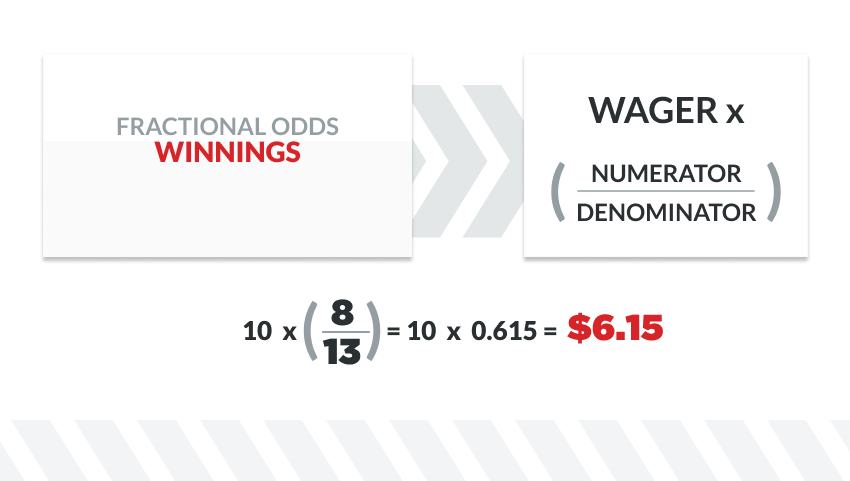
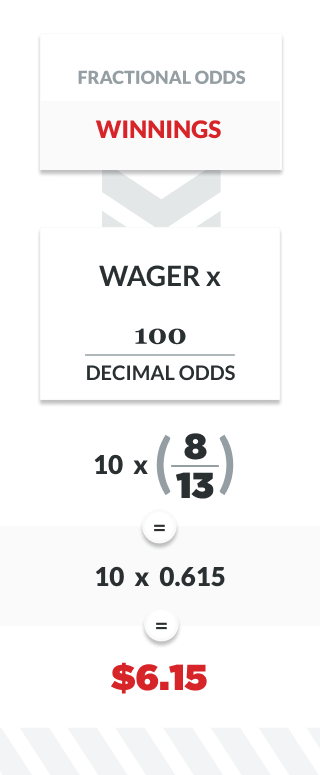
If you want to bet your $10 on Alvarez, multiply that sum by the quotient of 11 ÷ 8 (1.375). Your winnings would be $13.75 ($10 x 1.375).
Your payout would be $23.75 ($10 initial stake + your winnings of $13.75). Below is how to solve that using the formula.
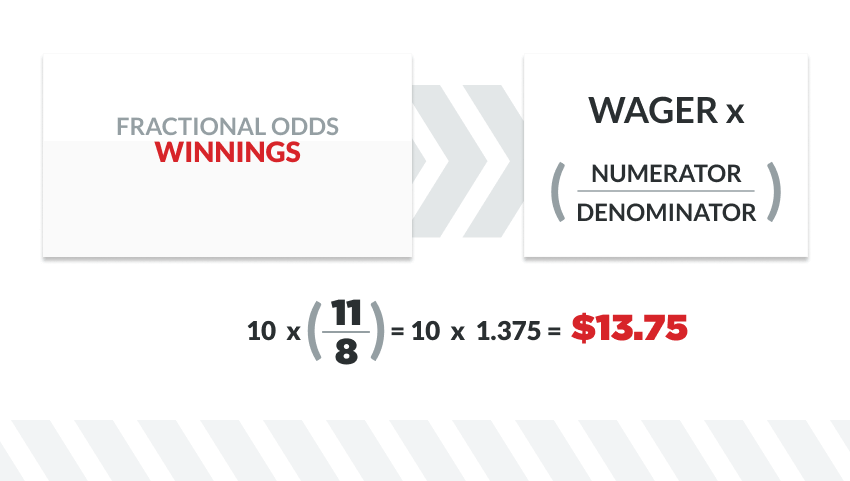
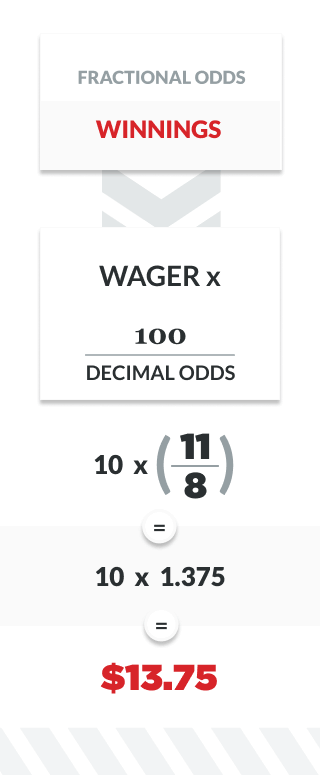
The potential winnings are greater when betting on Alvarez, the “underdog” in this fight. Betting on underdogs in any sport typically allows you to risk less in order to win more. Remember, however, that there’s a reason they are the underdog, whether it’s a rookie season, there’s been a recent injury, or they face serious competition.
If you side with Golovkin, the “favorite,” you’ll need to risk more to get the same winnings.
Let’s See What You’ve Learned
Use the formulas you’ve learned (and the fractional odds below) to answer the following questions:
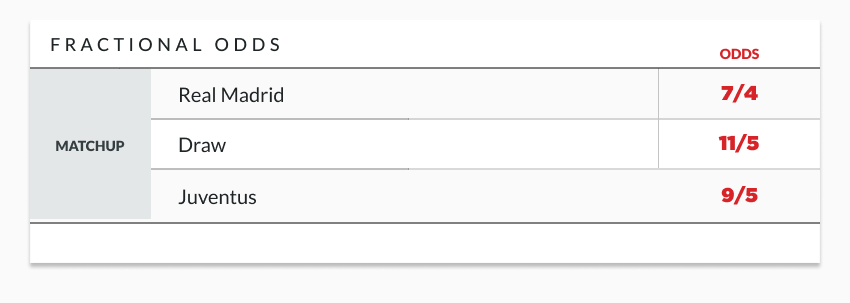
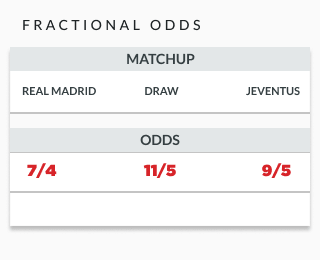
- Probability of Real Madrid Winning:
- Probability of a Draw:
- Probability of Juventus Winning:
- Winnings if betting $10 on Real Madrid:
- Payout if betting $10 on Real Madrid:
- Winnings if betting $10 on a Draw:
- Payout if betting $10 on a Draw:
- Winnings if betting $10 on Juventus:
- Payout if betting $10 on Juventus:
Answers (all percentages are rounded to one decimal place):
- Probability of Real Madrid Winning: 36.4%
- Probability of a Draw: 31.3%
- Probability of Juventus Winning: 35.7%
- Winnings if betting $10 on Real Madrid: $17.50
- Payout if betting $10 on Real Madrid: $27.50
- Winnings if betting $10 on a Draw: $22.00
- Payout if betting $10 on a Draw: $32.00
- Winnings if betting $10 on Juventus: $18.00
- Payout if betting $10 on Juventus: $28.00
What Is a Push?
While not technically related to odds, a push will definitely affect your payout. Every bettor should be aware of the possibility of a push before they lay their first wager on sports.
Simply put, a push is a tie.
You will not see pushes when betting on the money line. If a sport allows a matchup to end in a tie, that’s an outcome you can bet on. You only need to consider the possibility of a push when betting against the spread or placing a totals bet.
If a push does occur, you will simply be refunded your money. It will not count as a win or a loss.
Point spreads typically add a half point to each number to avoid the possibility of a push, but this isn’t always the case. Here is an example:

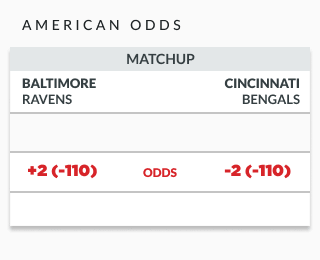
If this game were to end 20-18 for Cincinnati, neither team covered the spread and will be considered a push. In this circumstance, you’d be given your money back like the bet never happened.
Current Sports Betting Promotions
Take a look at our table with current sports betting promotions below to get a better idea of what online sportsbook you should go with for your first bet and beyond.
- BETMGM SPORTSBOOK
USE CODE SBD1500 & GET $1,500 BACK IN BONUS BETS
- BET365 SPORTSBOOK
BET $5 & GET $150 IN BONUS BETS WITH CODE DIME365
- FANATICS SPORTSBOOK
BET & GET UP TO $1,000 IN BONUS BETS!
- DRAFTKINGS SPORTSBOOK
BET $5 & GET $150 IN BONUS BETS INSTANTLY!
- FANDUEL SPORTSBOOK
BET $5 & GET $150 IF YOUR BET WINS
- CAESARS SPORTSBOOK
USE CODE SBD2DYW & BET $1 TO DOUBLE THE WINNINGS ON YOUR FIRST 10 BETS!
Must be 21+. GAMBLING PROBLEM? Call 1-800-GAMBLER (CO, IL, KS, KY, MD, MI, NC, NJ, OH, PA, TN, VA, VT, WV, WY); (800) 327-5050 or gamblinghelplinema.org (MA); (877) 8-HOPENY (NY); 1-800-NEXT-STEP (AZ); (888) 789-7777 (CT); 1-800-BETS-OFF (IA); 1-800-9-WITH-IT (IN); mdgamblinghelp.org (MD); morethanagame.nc.gov (NC); 1800gambler.net (WV)
As you can see, many of these online sportsbooks offer top-tier welcome offers for new users. Among the most accessible offers that really stand out in terms of value are the DraftKings and Bet365 promos while Caesars is fantastic for new users that are excited to bet a little more. BetMGM and FanDuel are also great middle-of-the-road promo options as well.
How to Read Odds FAQ
Still have more questions about how to read odds? Let’s see if we can help you out.
How do you read +/- odds?
The + (plus sign) indicates the underdog and the - (minus sign) indicates the favorite.
Are higher or lower odds better?
Higher odds can get you a larger payout but they're less likely to happen. Lower odds will get you a smaller payout but the outcome is more likely to happen.
What are the three types of odds?
Fractional, decimal, and American (moneyline).
Ready to Find Some Favorable Odds?
Now that you’re an expert in reading sports betting odds, get out there and start winning some money on your favorite sports betting sites! Sharp bettors are informed bettors, and not all sports are created equal. Consider checking out our comprehensive guide covering how to bet on sports before you lay down your first wager.
- BETMGM SPORTSBOOK
USE CODE SBD1500 & GET $1,500 BACK IN BONUS BETS
- BET365 SPORTSBOOK
BET $5 & GET $150 IN BONUS BETS WITH CODE DIME365
- FANATICS SPORTSBOOK
BET & GET UP TO $1,000 IN BONUS BETS!
- DRAFTKINGS SPORTSBOOK
BET $5 & GET $150 IN BONUS BETS INSTANTLY!
- FANDUEL SPORTSBOOK
BET $5 & GET $150 IF YOUR BET WINS
- CAESARS SPORTSBOOK
USE CODE SBD2DYW & BET $1 TO DOUBLE THE WINNINGS ON YOUR FIRST 10 BETS!
Must be 21+. GAMBLING PROBLEM? Call 1-800-GAMBLER (CO, IL, KS, KY, MD, MI, NC, NJ, OH, PA, TN, VA, VT, WV, WY); (800) 327-5050 or gamblinghelplinema.org (MA); (877) 8-HOPENY (NY); 1-800-NEXT-STEP (AZ); (888) 789-7777 (CT); 1-800-BETS-OFF (IA); 1-800-9-WITH-IT (IN); mdgamblinghelp.org (MD); morethanagame.nc.gov (NC); 1800gambler.net (WV)

Evergreen Manager; Sportsbook Expert
Following a sports journalism career with his work appearing in outlets like theScore, The Province, and VICE Sports, Patrick moved into the world of content marketing to bridge the gap between great writing and SEO success. He’s brought that same mindset to lead evergreen content efforts at SBD.




